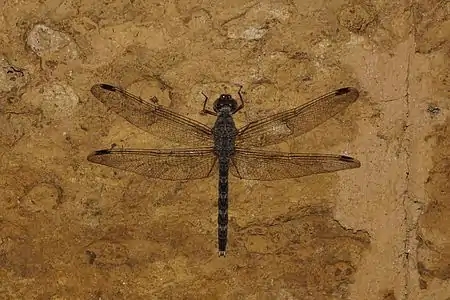Bradinopyga geminata
Bradinopyga geminata[2] is a species of dragonfly in the family Libellulidae known commonly as the granite ghost.[3][4] It is native to India, Sri Lanka and Thailand, where it is a common and widespread species.[1][5]
| Bradinopyga geminata | |
|---|---|
 | |
| Male | |
 | |
| Female | |
| Scientific classification | |
| Kingdom: | |
| Phylum: | |
| Class: | |
| Order: | |
| Family: | |
| Genus: | |
| Species: | B. geminata |
| Binomial name | |
| Bradinopyga geminata (Rambur, 1842) | |
Description and habitat
It is a medium sized dragonfly with brown-capped grey eyes. Its thorax is cinereous, marbled and peppered with black in a very irregular manner. Wings are transparent with dual color pterostigma, black at centre and pure white at distal and proximal ends. Abdomen is coloured very similarly to thorax; black marbled with yellow, but with a more definite plan. Segments 3 to 8 have pale basal annules interrupted on dorsum, and formed by two elongate parallel spots. There is a triangular apical sub-dorsal spot and a pale mid-dorsal spot. Anal appendages are creamy-white. Female is similar to the male.[6]
Taking advantage of its cryptic coloration, it always rests flat on slab rock or cement-plastered walls, where it almost invisible. Adults occupy habitat near water bodies, such as pools, irrigation channels, wells, and containers with standing water. It breeds in rainy hollows in the rocks or in wells and small cemented tanks.[6][7][8][3][4]
The species has been studied as a predator of the disease-carrying yellow fever mosquito (Aedes aegypti). The larvae of the dragonfly consume the larvae of the mosquito in the standing-water habitat types that both occupy.[9]
See also
- List of odonates of Sri Lanka
- List of odonates of India
- List of odonata of Kerala
References
- Mitra, A. (2010). "Bradinopyga geminata". IUCN Red List of Threatened Species. 2010: e.T167279A6321903.
- Martin Schorr; Dennis Paulson. "World Odonata List". University of Puget Sound. Retrieved 12 Oct 2018.
- "Bradinopyga geminata Rambur, 1842". India Biodiversity Portal. Retrieved 2017-03-17.
- "Bradinopyga geminata Rambur, 1842". Odonata of India, v. 1.00. Indian Foundation for Butterflies. Retrieved 2017-03-17.
- K.A., Subramanian; K.G., Emiliyamma; R., Babu; C., Radhakrishnan; S.S., Talmale (2018). Atlas of Odonata (Insecta) of the Western Ghats, India. Zoological Survey of India. pp. 312–313. ISBN 9788181714954.
- C FC Lt. Fraser (1936). The Fauna of British India, including Ceylon and Burma, Odonata Vol. III. Red Lion Court, Fleet Street, London: Taylor and Francis. pp. 349-350.
- C FC Lt. Fraser (1924). A Survey of the Odonate (Dragonfly) Fauna of Western India and Descriptions of Thirty New Species (PDF). p. 437.
- Subramanian, K. A. (2005). Dragonflies and Damselflies of Peninsular India - A Field Guide.
- Venkatesh, A., & Tyagi, B. K. (2015). Bradinopyga geminata (Anisoptera: Libellulidae) as a predator of Aedes aegypti immatures (Diptera: Culicidae). International Journal of Mosquito Research 2(2) 98-105.
